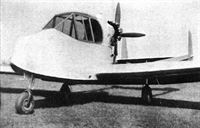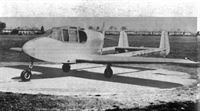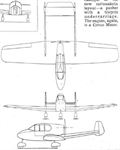
Описание
Страна : Великобритания
Год : 1938
Единственный экземпляр
Two-seat light cabin monoplane
Flight, November 1937
BRITISH CIVIL AIRCRAFT
The smaller types
ARPIN
THE first machine in this country to be designed around a tricycle type of undercarriage, the Arpin pusher, is a type which is now in process of development. Safety and comfort have been the two points for which the designer has striven. By placing the engine behind, an almost perfect field of useful view has been provided for the occupants, and the controls have been arranged so that it is almost impossible for the pilot to get into difficulties.
Generally speaking, the layout is somewhat similar to that of the Stearman-Hammond, which was described in last week's issue, the specification including twin fins and rudders supported on tailbooms, and a split flap, which extends unbroken from aileron to aileron. The engine to be fitted is a British Salmson of 68 b.h.p.
M. B. Arpin and Co., Longford, West Drayton, Middlesex.
Описание:
- Flight, November 1937
BRITISH CIVIL AIRCRAFT - Flight, March 1938
British light aircraft - Flight, May 1938
COMBINED VIRTUES - Flight, October 1938
British Sport and Training types - Flight, September 1939
To-day's Light Aeroplanes
Фотографии
-
Jane's All the World Aircraft 1938 / 03 - All the world's aeroplanes
Регистрационный номер: G-AFGB [11] The Arpin Two-seat Light Cabin Monoplane (68 h.p. Salmson engine).
-
Flight 1938-05 / Flight
Регистрационный номер: G-AFGB [11] This view give a good idea of the appearance of the prototype Arpin. The engine at present fitted is a 68 h.p. British Salmson.
-
Aeroplane Monthly 1976-09 / A.Ord-Hume - Arpin A-1 /British pre-war ultralights/
Регистрационный номер: G-AFGB [11] A view showing the three-piece split flaps
-
Air-Britain Archive 1980-03
Регистрационный номер: G-AFGB [11] As recorded above the Arpin A/1 did fly although it never received a C of A. G-AFGB is shown at Hanworth in its original 1938/9 configuration with Salmson radial, it later received a Cirrus Minor and a more streamlined nose cone and was finally scrapped in 1941.
-
Aeroplane Monthly 1976-09 / A.Ord-Hume - Arpin A-1 /British pre-war ultralights/
Регистрационный номер: G-AFGB [11] The Arpin A-1 at Hanworth shortly after completion in May 1938, showing the roomy two-seat cabin.
The Arpin pusher, shown here in prototype form, was the first machine in this country to be designed around the tricycle undercarriage. In production form it will be fitted with a Cirrus Minor engine. -
Flight 1938-09 / Flight
Регистрационный номер: G-AFGB [11] The Arpin pusher on which the experiments are being carried out with an undercarriage which is directionally adjustable on the ground. In actual practice the degree of “crab” will be adjustable from the pilot’s seat
-
Aeroplane Monthly 1976-09 / A.Ord-Hume - Arpin A-1 /British pre-war ultralights/
Регистрационный номер: G-AFGB [11] Demonstrating a cross-wind landing
-
Авиация и Космонавтика 2013-11 / Р.Вениаминов - "Рамы" небесные /Фотоархив/ (1)
Регистрационный номер: G-AFGB [11] Arpin A-1
-
Flight 1939-09 / Flight
Регистрационный номер: G-AFGB [11] The Arpin A-1 tricycle pusher in its latest form in 1939 with a 90 h.p. Blackburn Cirrus Minor I, re-positioned pitot head, new nose and static mass balances on rudders and ailerons.
-
Air-Britain Archive 1988-04
Регистрационный номер: G-AFGB [11] Luton LA3 Buzzard G-ADYX in its Mk II form with its 35 hp Anzani engine running but with the top of the cockpit cover removed. Visible in the background is the Arpin Tricycle G-AFGB.
Другие самолёты на фотографии: Luton Buzzard - Великобритания - 1936
-
Flight 1939-06 / Flight
Регистрационный номер: G-AFGB [11] The Arpin two-seat pusher (which was one of the pioneer "tricycle" designs in this country) is now flying with a Cirrus Minor engine in the new cowling seen here. The prototype had a Salmson.
-
Flight 1937-11 / Flight
The Arpin monoplane, which is now in course of construction, is a pusher with a tricycle undercarriage. Other features of interest will be gathered from a study of these general arrangement drawings.
-
Flight 1939-09 / Flight
The Arpin, an example of the new rationalistic layout - a pusher with a tricycle undercarriage. The engine, again, is a Cirrus Minor.
- Фотографии












